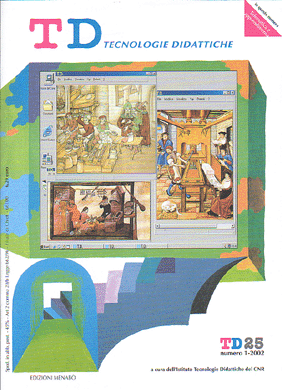Costruire mappe per cercare in rete: il metodo Sewcom
Contenuto principale dell'articolo
Abstract
Dettagli dell'articolo
Gli autori che pubblicano su questa rivista accettano le seguenti condizioni:
- Gli autori mantengono i diritti sulla loro opera e cedono alla rivista il diritto di prima pubblicazione dell'opera, contemporaneamente licenziata sotto una Licenza Creative Commons CC BY 4.0 Attribution 4.0 International License.
- Gli autori possono aderire ad altri accordi di licenza non esclusiva per la distribuzione della versione dell'opera pubblicata (es. depositarla in un archivio istituzionale o pubblicarla in una monografia), a patto di indicare che la prima pubblicazione è avvenuta su questa rivista.
- Gli autori possono diffondere la loro opera online (es. in repository istituzionali o nel loro sito web) prima e durante il processo di submission, poiché può portare a scambi produttivi e aumentare le citazioni dell'opera pubblicata (Vedi The effect of Open Access).
Riferimenti bibliografici
Jansen B. J., Spink A. and Saracevic T. (2000), Real life, real users and real needs: A study and analysis of users queries on the Web, Information Processing and Management, vol. 36, n. 2, pp. 207-227.
Jansen Bernard J., Pooch Udo (2001), A Review of Web Searching Studies and a Framework for Future Research, Journal of the American Society for Information Science and Technology, vol. 52, n.3, pp. 235-46.
Jonassen D. H., Peck K. L., Wilson B. G., Pfeiffer W. S. (1998), Learning with Technology: A Constructivist Perspective, Prentice Hall.
Jonassen D. H. & Grabowski B. L. (1993), Handbook of Individual Differences, learning and instruction, Lawrence Erlbaum Associates, Hillsdale, Part VII- Prior knowledge.
Kafai Y. and Marcia J. Bates (Spring, 1997), Internet Web-searching instruction in the elementary classroom: building a foundation for information literacy, School Library Media Quarterly, vol. 25, n.2, p.103-111.
Kuhlthau C. (1993), Seeking meaning: a process approach to library and information services, Ablex, Norwood (N.J.)
Kuhlthau C. (1996), Informatin needs and Information Seeking, Discussion paper for UCLA NSF Workshop.
Kuhlthau C. (1999), Accomodating the user ISP: Challenges for information retrieval system designers, Bulletin of American Society for Information Science, vol. 25, n.3, http://www.asis.org/Bul letin/fe-99/kuhlthau.html
Lancaster F. W., Elzy C., Zeter M. J., Metzler L. and Yuen M. L. (1994),. Comparison of the Results of End User Searching with Results of Two Searching by Skilled Intermediaries, RQ, vol. 33, n.3, pp.370-387
Landauer T. K. & Dumais S. T. (1997), A solution to Plato’s problem: The Latent Semantic Analysis theory of the acquisition, induction, and representation of knowledge, Psychological Review, n.104, pp. 211-240.
Lavigne F., Vitu F. and d’Ydewalle Géry (2000), The influence of semantic context on initial eye landing sites in words, Acta Psychologica, n. 104, pp. 191-214.
McKenzie J. (1995), Grazing the Net: Raising a Generation of Free Range Students- Part One, http://fromnowon.org/g razing1.html
Meara P. (1978), Learners’ word associations in French Interlanguage, Studies Bulletin Utrecht, vol. 3, n. 2, pp. 192-211. Miller G.A., Charles W.G. (1991), Contextual Correlates of Semantic Similarity, Language and Cognitive Processes, vol. 6, n. 1, pp. 1-28.
Moore P. & Fitz C. (1993), Gestalt Theory and Instructional Design, Journal of Technical Writing and Communication, vol. 23, n.2, pp. 137- 157.
Pacetti L. (1999), Navigando nel Cyberspazio, in P. Bartolini (a cura di), Ricerca sui rapporti tra infanzia e Internet, BUR, Milano, pp. 142
Pantò E., Petrucco C. (1994), Internet per la didattica: dialogare a scuola col mondo, Apogeo ed., Milano.
Papert S. (1994), I bambini e il computer, Rizzoli, Milano.
Plaut D. (2000), Individual and Developmental Differences in Semantic Priming: Empirical and Computational Support for a Single-Mechanism Account of Lexical Processing, Psychological Review, http://facultyweb. at.nwu.edu/speech/ booth/james/papers/ PlautBooth.PR.2000 .pdf
Pontecorvo C., Aiello A.M., Zucchermaglio C. (1995), (a cura di), I contesti sociali dell’apprendimento. Acquisire conoscenze a scuola, nel lavoro, nella vita quotidiana, Ambrosiana, Milano.
Quillian M. R. (1968), Semantic Memory, in Minsky (eds) Semantic Information Processing, MIT Press, Cambridge (MA)
Rhodes G. & Tremewan T., (1993), The Simon then Garfunkel effect: Semantic priming, sensitivity and the modularity of face recognition, Cognitive Psycology, n. 25, pp. 147-187.
Schacter J. et al. (1998), Children’s Internet searching on complex problems: performance and process analyses, Journal of the American Society for Information Science, vol. 49, n. 9, pp. 840-49.
Schoenfeld A. H. (1987), What’s all the fuss about metacognition?, Cognitive Science and mathematics education Erlbaum, Hillsdale (NJ), pp. 189- 215.
Scimeca S. (1995), Considerazioni per un uso didattico del World Wide Web, Istituto Tecnologie Didattiche, CNR - Genova.
Stahl S. A. (1999), Vocabulary development, Brookline Books, Cambridge (MA).
Teitelbaum S. and Sewell W. (1986), Online Searching Behavior Over Eleven Years, Journal of American Society of Information Science, vol. 37, n. 4, pp. 234-245
Tolle J. E. and Hah S. (1985), Online Search Patterns, Journal of American Society of Information Science, vol. 36, n. 2, pp. 82-93.
Twidale M. B., Nichols D. M., Smith G., Trevor J. (1995), Supporting Collaborative Learning during Information Searching, Proceedings of Computer Support for Collaborative Learning (CSCL’95), October 17- 20, Indiana University, Bloomington, Indiana, pp. 367-74 (disponibile presso il Computing Department Lancaster University).
Walker J. R., Moen William E. (2001), Identifying and Categorizing Information Seeking Behaviors in the Networked Environment: An Exploratory Study of Young Adults, School of Library and Information Sciences University of North Texas, Final Report.

